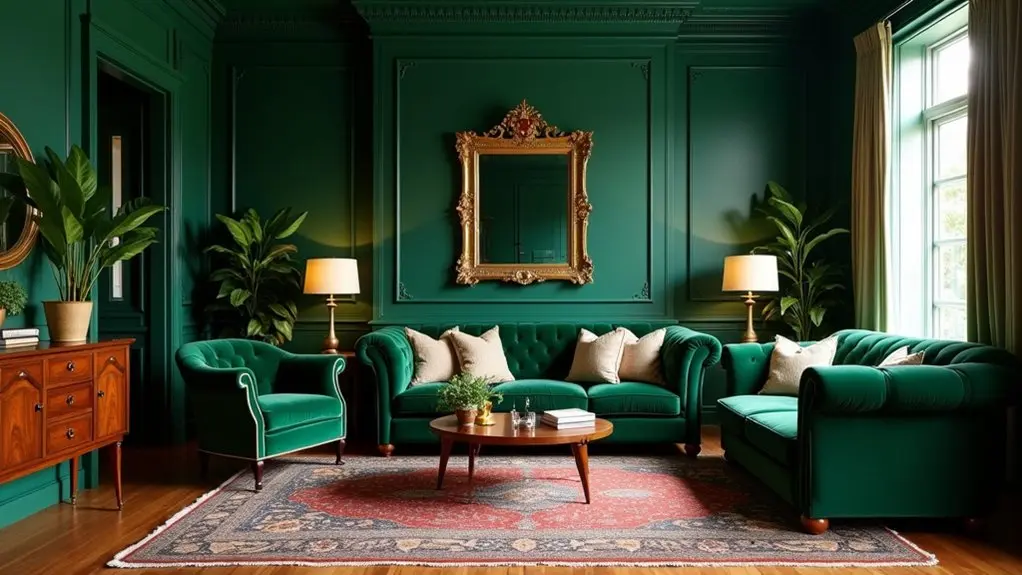
18 Dark Green Living Room Ideas That Are Moody and Sophisticated
Dark green living rooms achieve moody sophistication with monochrome palettes, enveloping wall colors, and layered textures like velvet, wood, and stone. Botanical accents and curated artwork add visual depth, while gold lighting and metallic accessories introduce warmth and luxury. Architectural features such as dark wood paneling or shiplap modernize and anchor the design. The interplay of rich hues with organic materials creates an immersive, calming ambiance. Discover thoughtfully curated ideas to inspire a transformative living space.
Key Takeaways
- Paint walls, trim, and ceilings in a deep green monochrome scheme for a tranquil, immersive, and cohesive living room backdrop.
- Layer plush textures like velvet, knits, and natural materials such as wood and rattan to add warmth, depth, and tactile interest.
- Incorporate botanical prints and real plants to introduce dynamic green hues, visual variety, and a revitalizing, biophilic ambiance.
- Curate a gallery wall with gold frames and diverse art styles to create sophisticated focal points and visual intrigue against dark green walls.
- Use gold lighting fixtures and sculptural lamps to enhance richness, reflect warm light, and highlight architectural features for a dramatic effect.
Layer in Shapes and Textures
A sophisticated dark green living room benefits from the deliberate interplay of varied shapes and textures. Against dark green walls, geometric furniture introduces modern appeal, lending visual complexity through angular silhouettes and sculptural forms.
Layering different textures—such as plush velvet cushions, woven throws, or tactile boucle upholstery—softens the boldness of the color, cultivating a cozy yet curated ambiance. Abstract wallpaper or artwork unifies the design, drawing attention to dynamic patterns while complementing the moody aesthetic.
Integrating natural materials like wood and rattan with dark green tones injects warmth and organic depth, striking balance within the dramatic palette. A fireplace enhanced with textured stone or tile acts as a focal point, enriching the layered composition and reinforcing the room’s sophisticated, multidimensional narrative.
Go for Dark, Moody Walls
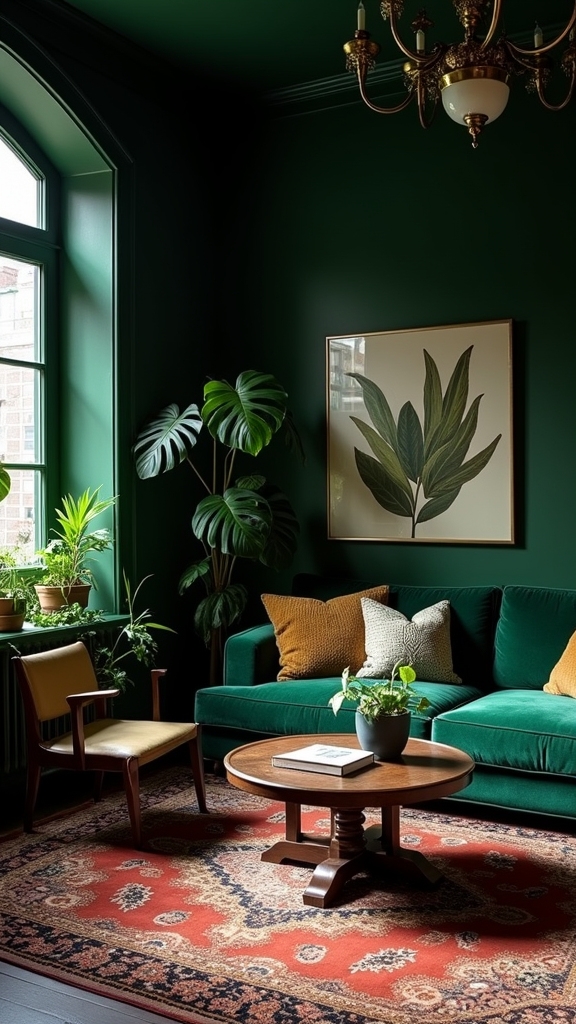
Selecting deep green hues for living room walls establishes a moody, immersive backdrop that exudes sophistication and serenity.
This dramatic foundation pairs elegantly with layered luxe textures—think velvet upholstery, silk drapery, or matte metallics—to enhance visual interest and tactile richness.
Contrasting accents, such as vibrant artwork or sculptural lighting, punctuate the space and draw the eye, ensuring a dynamic and balanced composition.
Embrace Deep Green Hues
Although often associated with traditional interiors, deep green hues such as ‘Invisible Green’ and ‘Cooking Apple Green’ introduce a sophisticated, moody character that enhances living room design.
Dark green walls create an enveloping effect, establishing depth and a sense of intimacy within the space. These rich green tones serve as an ideal backdrop, amplifying the visual impact of curated furnishings and artwork while promoting an elegant look.
The versatility of dark green allows it to complement both modern and classic aesthetics, effortlessly pairing with metallic finishes, such as brass, or the tactile appeal of velvet upholstery.
To maintain balance, designers often juxtapose deep wall colors with lighter furnishings or natural wood accents, ensuring the atmosphere remains welcoming and visually harmonious without sacrificing drama or sophistication.
Layer With Luxe Textures
Velvet upholstery, tactile knits, and polished brass fixtures converge to enhance the drama of dark, moody living room walls in shades like ‘Invisible Green’ and ‘Cooking Apple Green’. These rich tones provide a sophisticated canvas for layering different textures, which amplifies both comfort and visual intrigue. A dark green sofa in sumptuous velvet furnishings anchors the space, while knitted throws and plush cushions deliver inviting warmth. Brass accents—be it slim light fixtures or sculptural decor—reflect ambient light, adding elegance and depth. For a harmonious yet dynamic look, incorporate artwork with botanical or tropical motifs to punctuate the depth of the walls.
| Texture Element | Design Impact |
|---|---|
| Velvet furnishings | Luxurious tactile depth |
| Knitted throws | Added warmth and softness |
| Brass fixtures | Elegant reflective contrast |
| Plush cushions | Enhanced comfort layering |
Highlight With Contrasting Accents
A strategic interplay of contrasting accents can amplify the allure of dark, moody green walls, transforming the living room into a sophisticated retreat.
Light-toned furnishings—such as cream sofas or ivory rugs—introduce visual relief, counterbalancing the enveloping depth of dark green walls.
Carefully curated metallic elements, like brass light fixtures or gold-trimmed mirrors, punctuate the space with luminous highlights that enhance the overall ambiance.
Incorporating vivid decor or artwork in complementary hues creates dynamic focal points, infusing the room with energy while maintaining cohesion.
Texture is key: pairing velvet upholstery or polished wood against the matte richness of the walls adds tactile depth.
These deliberate combinations of contrasting accents guarantee the room remains inviting, moody, and wholly refined—never overwhelming or monotonous.
Create Contrast With Wood Paneling
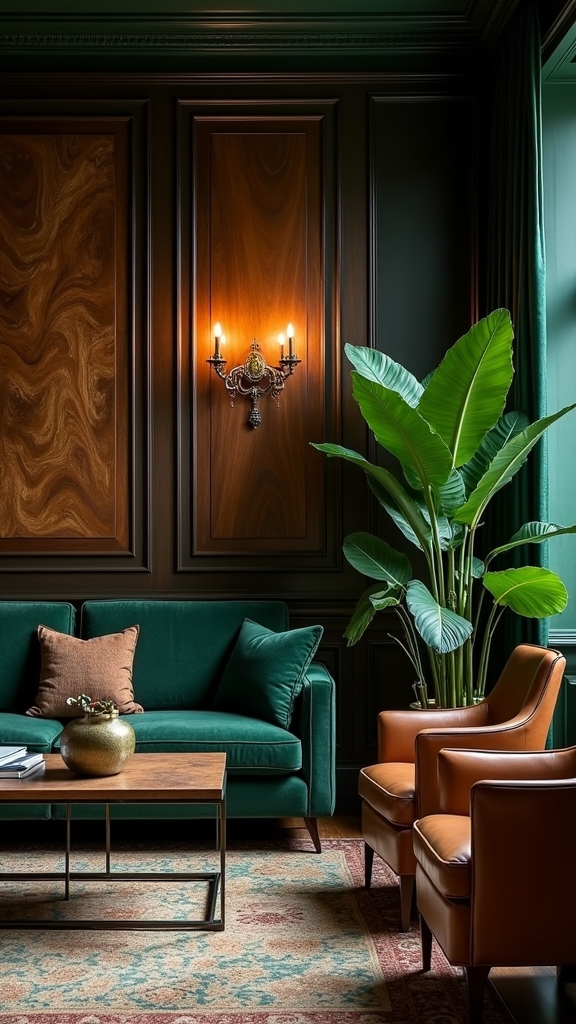
Pairing dark green walls with natural wood paneling establishes a harmonious balance, where the organic warmth of timber counteracts the intensity of deep color.
Extending the green onto the ceiling can envelop the room in a cocooning effect, while wood accents provide visual relief and architectural interest.
Thoughtfully layered metallic or textile accents further enhance the design, enhancing both warmth and sophistication.
Balancing Green With Wood
Wood paneling introduces warmth and tactile depth to a dark green living room, serving as a counterbalance to the richness of the wall color. When integrated thoughtfully, wood paneling breaks the visual dominance of dark green, infusing the space with organic texture and visual intrigue.
Designers often opt for natural wood accents—such as trims, beams, or custom-built shelving—in lighter oak or ash finishes to accentuate architectural features and prevent the room from feeling too saturated. The interplay between dark green surfaces and wood paneling creates a sophisticated contrast, enhancing both elements while grounding the overall aesthetic.
For added nuance, painting wood paneling in muted tones, like soft beige or white, maintains brightness and guarantees the space remains inviting, cozy, and visually harmonious.
Extending Color to Ceiling
When dark green paint is carried onto the ceiling, the space achieves an enveloping, monochromatic effect that amplifies its moody ambiance and design cohesion.
This immersive approach blurs the boundaries between walls and ceiling, visually lowering the room’s height to foster intimacy and a sense of retreat.
Introducing wood paneling in natural, contrasting tones breaks up the expanse of dark green, injecting warmth and organic texture without interrupting the sophisticated palette.
The interplay between the deep green surfaces and the tactile quality of wood paneling creates a layered, harmonious environment.
Integrating gold lighting fixtures against this backdrop enhances the overall look, accentuating the interplay of color and material.
The result is a living room that feels both elegant and grounded, with carefully curated contrasts.
Enhancing Warmth With Accents
Although dark green walls establish a dramatic foundation, the introduction of wood paneling infuses essential warmth and tactile contrast into the living room’s design.
Light wood tones, such as oak or maple, juxtaposed with dark green walls, generate visual depth while preventing the space from feeling overly somber.
Wood paneling, whether applied to the ceiling or as an accent wall, not only draws the eye upward but also imparts a sense of expansiveness despite the room’s moody palette.
Strategic placement of wood paneling can highlight architectural features like fireplaces or built-in shelving, enhancing the room’s character and sophistication.
This combination of dark green hues and warm wood elements results in a living space that feels both balanced and inviting, underscoring timeless elegance.
Keep It Monochrome
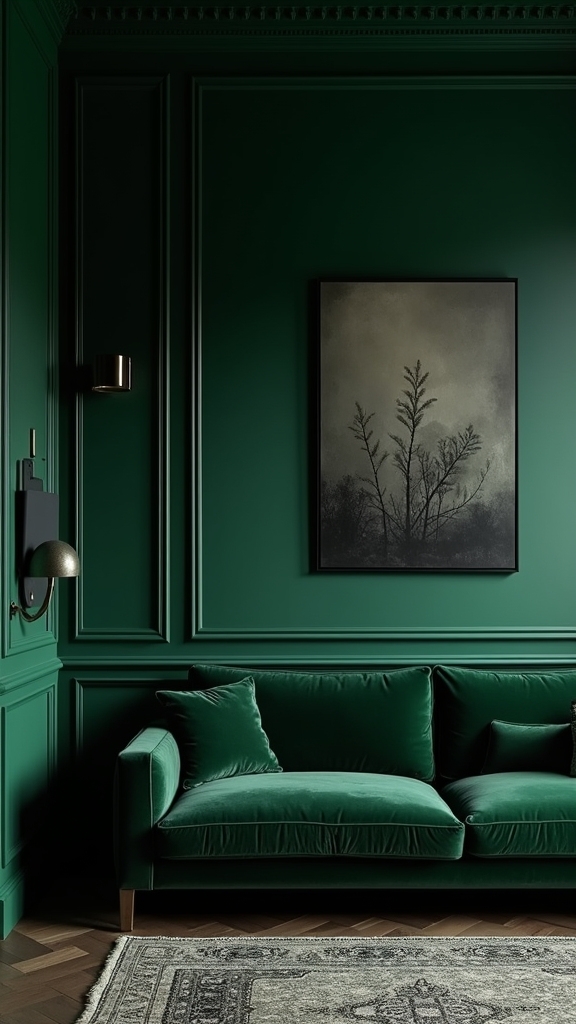
By embracing a monochrome palette anchored in dark green, a living room can achieve a seamless sense of tranquility and cohesion. Monochrome design in this context involves layering various shades of green—ranging from deep forest to subtle sage—across walls, trim, and furnishings. This nuanced approach creates visual depth while maintaining a unified aesthetic. Rich textures, such as velvet sofas, boucle armchairs, and knitted throws, introduce dimension and tactile warmth, ensuring the room remains inviting rather than austere. Green accents—pillows, vases, or rugs—can punctuate the scheme, adding subtle variation within the established hue. Metallic elements, like brass lighting fixtures or decor, inject contrast and enhance the sophistication of the monochrome design, fostering an atmosphere that is both refined and harmonious. To further elevate the design, consider incorporating sleek leather and plush velvet for textural contrast, drawing inspiration from contemporary monochrome living room styles.
Tie It Back to Nature
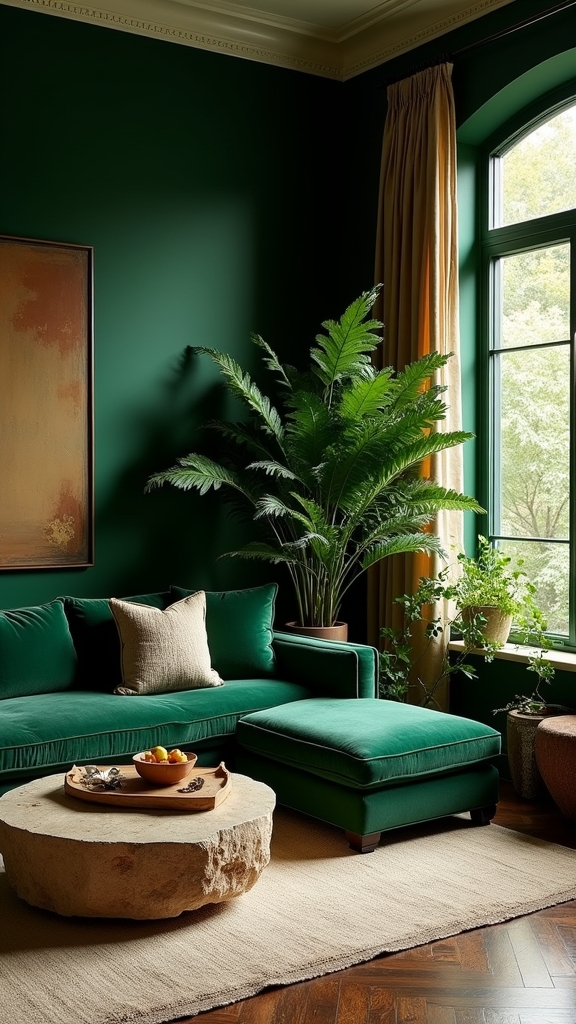
Grounding the living room in nature begins with embracing earthy green tones that evoke a calming, organic ambiance. Layering tactile materials—such as raw wood, woven wicker, and natural stone—amplifies the biophilic effect and introduces depth through texture. Botanical accents, whether through lush houseplants or verdant prints, infuse energy and reinforce the cohesive nature-inspired palette. Incorporating Dieffenbachia’s large variegated leaves creates a dynamic aesthetic while enhancing air quality and mood.
Embrace Earthy Green Tones
Earthy green tones, such as the muted sophistication of ‘Invisible Green’ and the gentle freshness of ‘Cooking Apple Green’, anchor a living room in tranquility by echoing the serene palettes found in nature.
These green shades establish a calming foundation, fostering relaxation and a sense of retreat within the home. Designers often layer various hues—from deep green to delicate sage—to achieve visual depth and cohesion without overwhelming the space.
Accents in earthy tones, like cushions and rugs featuring subtle botanical prints, reinforce the organic ambiance while maintaining a refined aesthetic.
Integrating deep green walls with thoughtfully selected decor creates a moody yet sophisticated backdrop that feels both timeless and grounding.
This approach subtly ties the interior environment back to its natural roots, enhancing overall harmony.
Layer Natural Materials
A layered interplay of natural materials—wood, stone, rattan—infuses a dark green living room with warmth and tactile richness, establishing a dialogue between interior and environment. Natural wood beams overhead provide architectural interest, their organic grain enhancing the enveloping dark green walls. Earthy tones in furnishings, such as terracotta pots or clay vessels, ground the palette, while a reclaimed wood coffee table or woven jute rug introduces depth and visual intrigue. Living plants—lush ferns or upright snake plants—add a vibrant, biophilic contrast, echoing the room’s verdant hues. Maximizing daylight with ample windows accentuates the textures and subtle sheen of these materials, creating a harmonious, sophisticated retreat.
| Material | Design Element |
|---|---|
| Natural wood | Exposed beams, reclaimed tables |
| Stone | Slate-topped sideboard, hearth |
| Rattan | Woven accent chairs, baskets |
| Plants | Ferns, snake plants in clay vessels |
Incorporate Botanical Accents
While the enveloping drama of dark green walls establishes an elegant foundation, the introduction of botanical accents enhances the space by weaving in biophilic motifs and organic vibrancy.
Botanical prints—whether as leafy wallpapers, cushion covers, or curated art pieces—infuse visual intrigue and reinforce the room’s connection to nature. Real plants, such as ferns, snake plants, or trailing vines, introduce dynamic green hues and textural variety, amplifying depth while also purifying the air and encouraging tranquility.
Integrating various tones within botanical elements, from rich emeralds to muted sages, sustains a harmonious yet layered palette.
Completing the composition, natural materials like wooden furniture or woven baskets lend tactile warmth, anchoring the design in earthy authenticity and underscoring the sophisticated, moody ambiance of the dark green living room.
Add a Gallery Wall
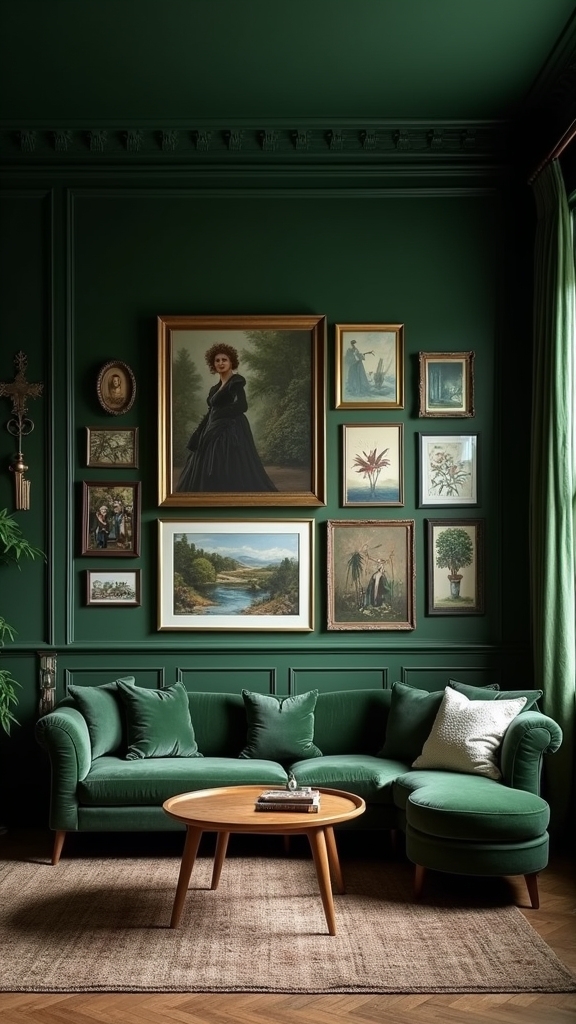
Transforming a dark green living room with a curated gallery wall introduces a refined focal point that amplifies both visual intrigue and atmosphere.
Gallery walls become especially compelling against dark green walls, as the rich backdrop intensifies the impact of curated artwork. Designers often recommend mixing frame finishes—such as sleek black and brushed gold—for layered sophistication.
Incorporating a range of art styles, from lush tropical prints to abstract compositions, enlivens the moody palette while adding dynamic visual movement. Varying the scale and orientation of artwork pieces heightens depth, turning the gallery wall into an immersive experience.
Placement is also key; situating the gallery where natural or accent lighting can highlight each piece preserves the room’s enveloping ambiance.
- Mix black and gold frames for contrast
- Combine abstract and tropical prints
- Use varied artwork sizes for dimension
- Position the gallery wall in well-lit zones
- Select art that complements dark green walls
Opt for Neutral Accents
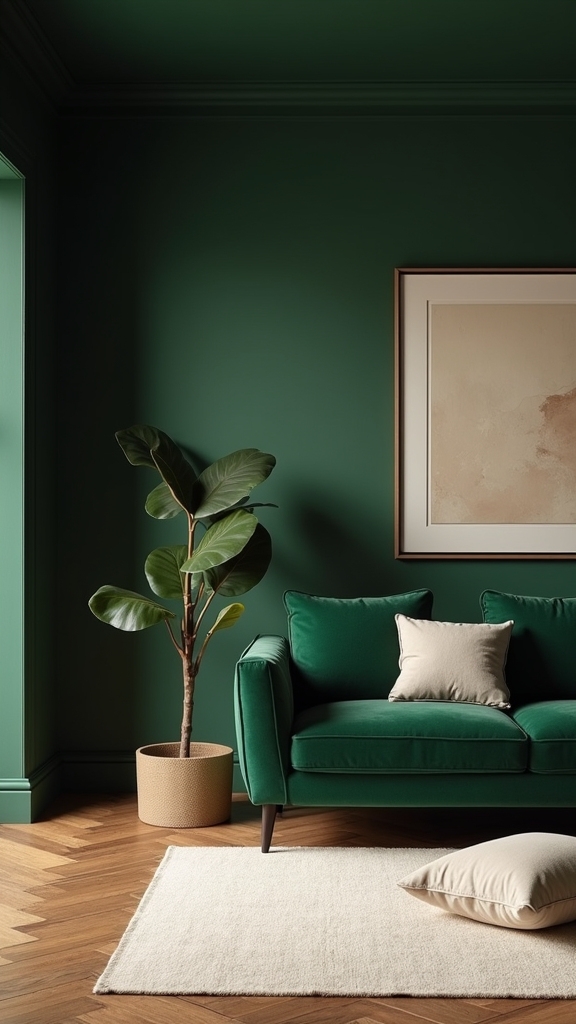
Next to the dynamic presence of a gallery wall, introducing neutral accents establishes equilibrium within a dark green living room. Neutral accents—such as beige, cream, or taupe—soften the visual intensity of dark green walls, curating a balanced and sophisticated aesthetic. Furniture choices in light gray or cream create striking contrast, providing relief while preserving elegance. Layering textiles, like pillows and throws in understated hues, injects tactile interest and depth without overpowering the room’s saturated palette. A neutral area rug grounds the space, lending warmth and cohesion. Additionally, integrating wooden furnishings or metallic decor in muted brass tones furthers the room’s harmonious appeal. Incorporating greenery with low-light plants adds natural beauty and air purification, enhancing the visual impact while maintaining a calming atmosphere. These elements collectively guarantee that the moody richness of dark green walls feels inviting, refined, and thoughtfully composed.
Pair Green With Gold
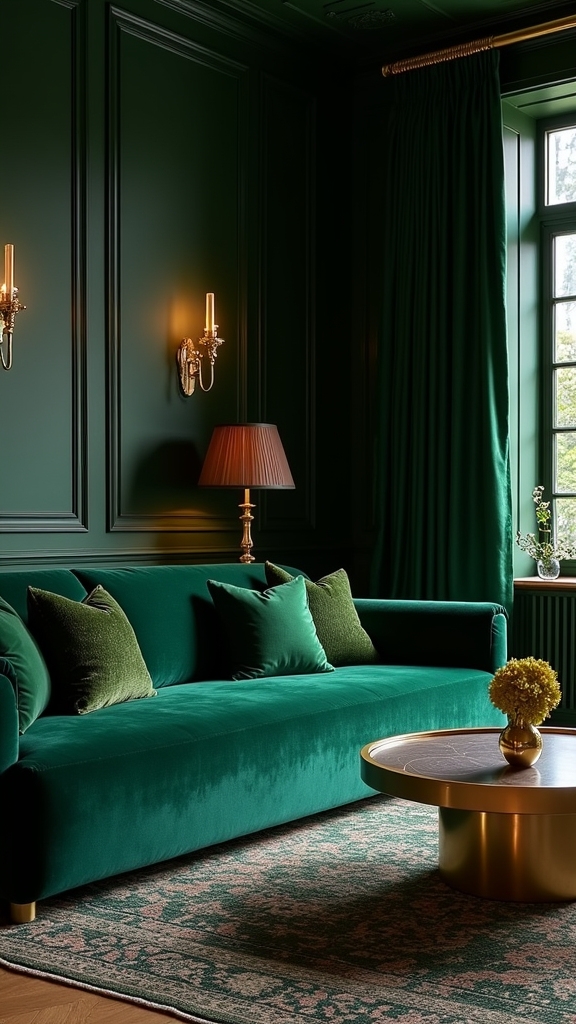
Pairing dark green with gold introduces an opulent interplay of color and material, where brass accents instantly lift cabinetry and furnishings.
Gold-framed art delivers moments of visual punctuation against the moody backdrop, while luxe lighting fixtures add both radiance and sculptural interest.
This harmonious blend enhances spatial sophistication and underscores the room’s curated aesthetic.
Elevate With Brass Accents
A gleaming brass chandelier suspended above a velvet, dark green sofa instantly introduces a sense of luxury and refinement to a living room.
Brass accents, when paired with deep green hues, create a sophisticated interplay of warmth and opulence, elevating the moody ambiance. The reflective nature of brass not only brightens the space but also draws attention to the richness of the green palette. Each brass element serves as a deliberate focal point, balancing the enveloping darkness with luminous highlights.
For those seeking a polished, contemporary look, consider integrating brass in the following ways:
- Statement brass lighting fixtures or chandeliers
- Sculptural brass side tables or coffee tables
- Decorative brass vases or candleholders
- Sleek brass hardware on cabinetry or shelving
- Ornate brass mirrors or trim detailing
Gold-Framed Art Highlights
Opulence emerges when gold-framed art is set against the enveloping backdrop of dark green walls, instantly amplifying the room’s visual drama and sophistication.
The interplay between gilded frames and richly pigmented walls introduces a sense of grandeur, as gold accents punctuate the space with luminous warmth.
Art pieces, whether abstract compositions or classic portraits, become striking focal points when bordered in gold, their presence heightened by the deep, saturated green.
This thoughtful pairing not only enhances the visual richness but also balances the moody ambiance with reflective surfaces that capture and disperse light.
The strategic placement of gold-framed art pieces establishes a curated gallery effect, lending an air of refinement that underscores the luxurious essence of a dark green living room.
Luxe Lighting Fixtures Shine
Illumination becomes an art form when gold lighting fixtures are introduced into a dark green living room, forging a harmonious union between luxury and depth.
The pairing of gold accents with dark green walls amplifies the richness of the space, as the metallic sheen reflects warm, ambient light, enhancing the moody undertones.
Strategic placement of gold lighting fixtures—such as sculptural chandeliers, sleek sconces, or opulent lamp bases—heightens the visual drama while accentuating architectural interest.
- Gold chandeliers create a dazzling centerpiece above seating areas.
- Table lamps with gilded bases offer subtle, layered lighting.
- Wall sconces in brushed gold frame and emphasize focal points.
- Pendant lights with metallic finishes add contemporary flair.
- Picture lights in gold highlight artwork, increasing depth and sophistication.
This combination guarantees timeless elegance and refined ambiance.
Give Wood Panels a Refresh
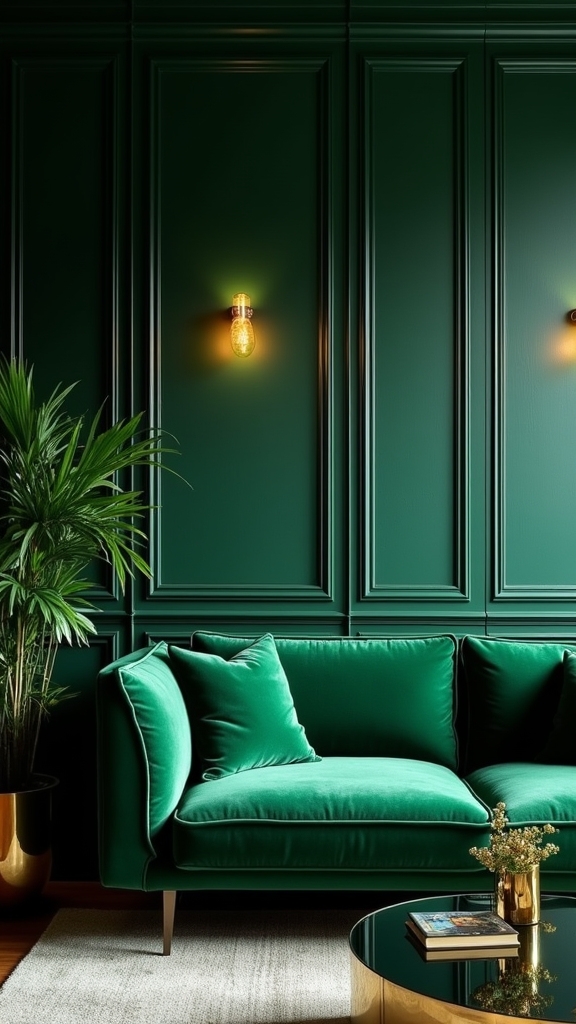
Transforming wood panels with deep green-blue hues instantly updates a living room’s architectural character, shifting dated features into striking, modern focal points.
Applying green paint to original paneling introduces a modern twist, infusing traditional millwork with renewed vibrancy. This approach preserves the warmth and texture of natural wood while delivering a contemporary palette that feels both moody and sophisticated.
Designers often balance the deep green panels with neutral upper walls—think alabaster or dove gray—for a harmonious, layered effect.
For enhanced cohesion, extending the green paint across select architectural details creates seamless visual continuity throughout the space.
Metallic accents, such as brass sconces or gold-trimmed mirrors, establish contrast and boost the sophistication, ensuring the refreshed wood panels anchor the room with both charm and modernity.
Incorporating metallic accents in gold and brass enhances the living room’s elegance, adding richness and warmth to the overall decor.
Add Shiplap to Your Fireplace
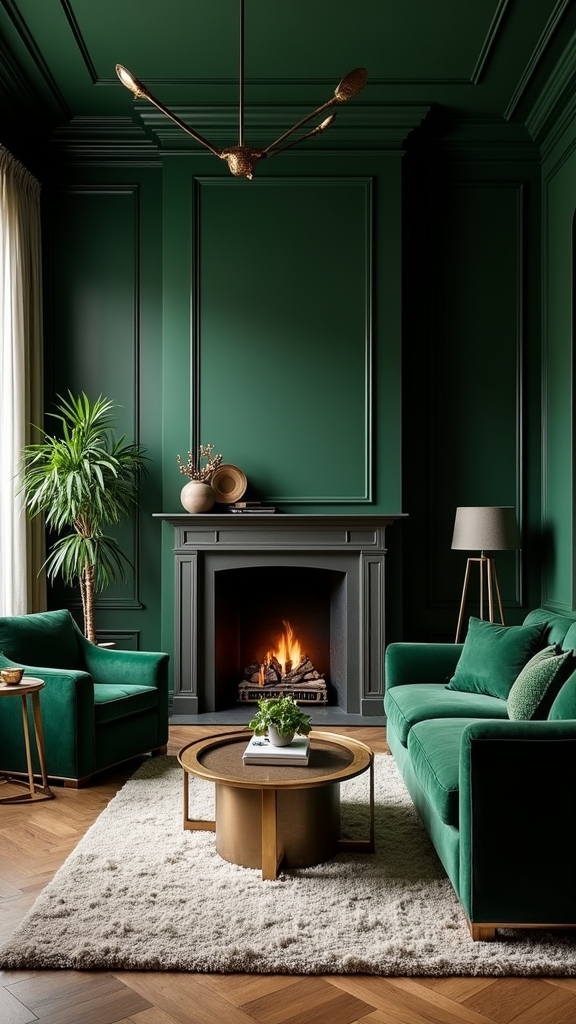
Although often associated with breezy coastal interiors, shiplap takes on a bold new character when wrapped around a fireplace in a deep, earthy green. This design move delivers a dramatic focal point that instantly grounds a moody living room.
When painted in a rich green hue, shiplap introduces both texture and warmth to the fireplace, enhancing the overall ambiance with a sophisticated edge. The interplay of color and dimensional paneling creates an inviting retreat while reinforcing the room’s cohesive palette.
For a layered, nature-inspired look, designers recommend integrating organic elements and strategic styling choices.
- Choose vertical or horizontal shiplap patterns for distinct visual effects
- Select a green hue that complements existing furnishings
- Layer with natural materials like reclaimed wood or stone
- Accent with lush greenery or botanical artwork
- Incorporate matte or satin finishes for added depth
To maintain a clutter-free environment, consider using built-in storage and multi-functional furniture to maximize space efficiency.
Opt for Stripes
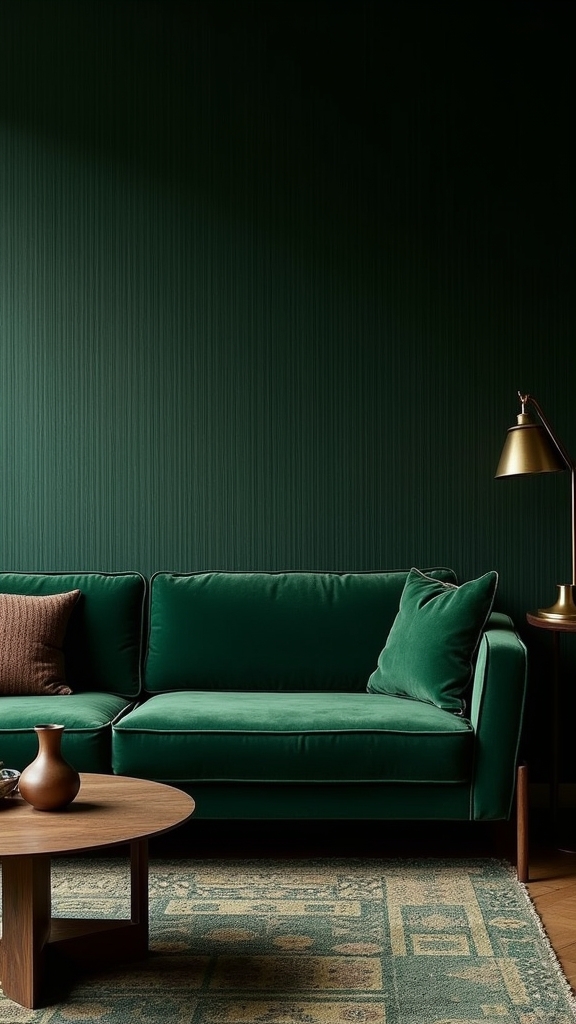
Introducing playful patterned wallpaper in dark green stripes instantly injects both rhythm and sophistication into a living room’s palette.
Designers often coordinate striped accents—such as cushions or area rugs—to reinforce the motif and achieve visual harmony.
This layered approach to pattern delivers spatial interest while preserving a cohesive, curated aesthetic.
Playful Patterned Wallpaper
When layered against dark green walls, striped wallpaper introduces a dynamic interplay of pattern and color that enhances the visual intrigue of a living room.
Playful patterned wallpaper in green tones enlivens moody spaces, seamlessly blending sophistication with a hint of whimsy. Stripes—whether bold or subtle—create dramatic contrast, injecting energy without overwhelming the rich, enveloping ambiance.
Employing striped wallpaper can maximize spatial perception, making compact rooms appear expansively open. Customizing stripes with masking tape further personalizes the effect, allowing individual expression through varied widths or alternating hues.
- Adds playful elegance and visual depth to dark green living rooms
- Enhances spatial perception, ideal for narrow or small spaces
- Enables customization with masking tape for bespoke patterns
- Harmonizes with brass, velvet, and other luxe materials
- Offers a vibrant yet cohesive backdrop with green tones
Coordinated Striped Accents
A considered application of striped accents infuses a dark green living room with structured rhythm and visual cohesion. Striped wallpaper, especially in alternating shades of green, introduces depth and dimension, fostering a dynamic yet moody ambiance.
When employed as an accent wall, such wallpaper becomes a focal point, balancing sophistication with playful geometry. For a bespoke look, DIY enthusiasts can utilize masking tape to craft custom striped designs, offering versatile scale, orientation, and color gradation.
Layering striped decorative pillows or throws further reinforces the motif, linking disparate elements within the room for a harmonious effect. This strategic use of stripes is both budget-friendly and transformative, granting the space visual interest and a curated sense of character without necessitating major renovation.
Pair Mossy Greens With Browns
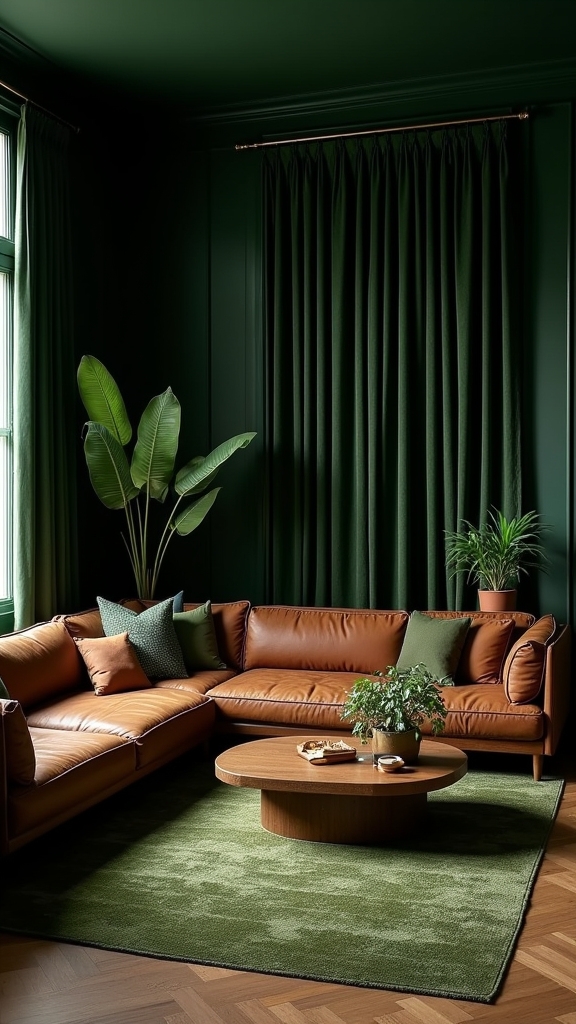
Mossy greens, with their muted, organic undertones, establish a serene foundation that is effortlessly raised by the inclusion of rich brown elements. This combination embraces an earthy palette, grounding the living room in tranquility and sophistication.
Brown leather seating introduces warmth and tactile luxury, harmonizing flawlessly with mossy green walls or accents. The interplay of these hues and textures enhances depth, making the space feel layered and inviting.
Whether adopting a rustic or contemporary aesthetic, this dynamic pairing remains timeless and versatile. For an elevated, design-driven approach:
- Incorporate brown leather sofas for tactile contrast
- Layer knitted throws and plush rugs in earthy browns
- Use wooden beams or coffee tables to reinforce natural tones
- Paint walls in mossy greens for a soothing backdrop
- Blend rustic and modern elements for visual intrigue
The inclusion of reclaimed wood furniture offers sustainable allure and a storied past, seamlessly blending with the earthy tones and enhancing the farmhouse decor’s authenticity.
Create an Accent Around Your Mantel
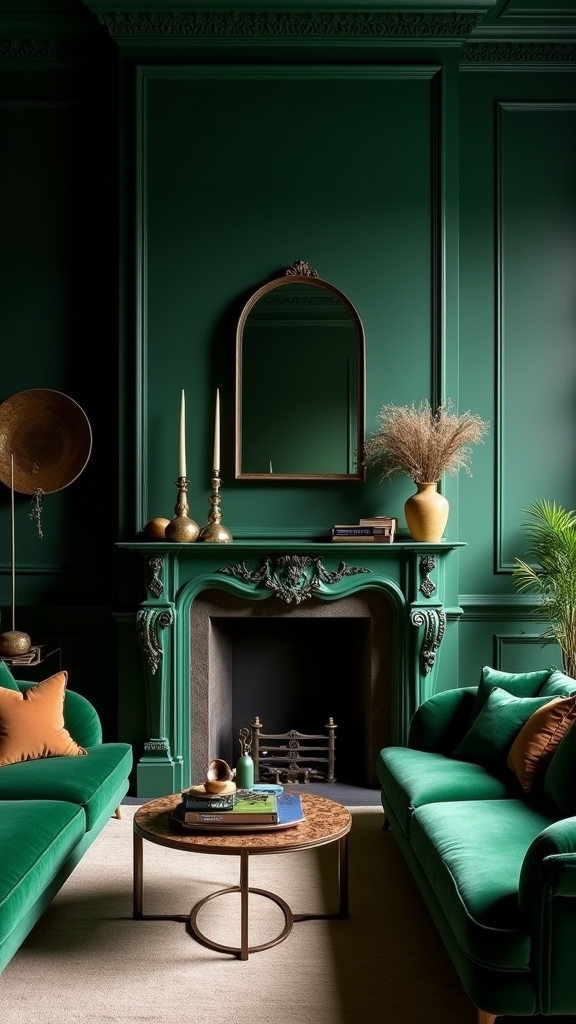
Although often overlooked, the fireplace mantel serves as a natural focal point that can dramatically influence a living room’s ambiance, especially within a dark green palette. To maximize this effect, designers recommend using bold colors for the mantel itself, creating an accent that stands out against dark green walls.
Incorporating shiplap or deep green paneling around the mantel introduces tactile dimension and raises visual interest. A contrasting light-colored mantel offers visual relief, ensuring the architectural feature remains prominent yet refined.
Surrounding the mantel with decorative elements—such as curated artwork, sculptural candles, or lush greenery—establishes a cohesive narrative, tying the vignette into the room’s moody sophistication. The integration of natural materials like wood, stone, or brass subtly enhances warmth and harmonizes with the enveloping green scheme. Incorporating 3D tiles as textured wall panels around the mantel can further elevate the room’s ambiance by playing with light and shadow, adding depth and modern design flair.
Mix Greens With Blues
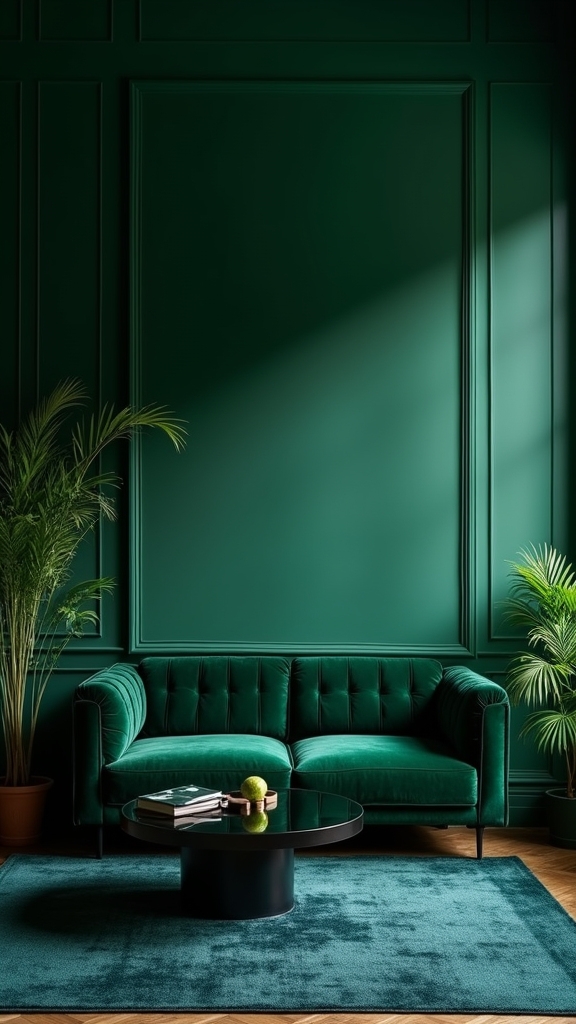
Beyond accentuating the mantel, the interplay between green and blue hues introduces nuanced complexity to a living room’s palette.
The fusion of dark green with blue elements—such as a plush blue sofa set against olive green walls—creates a layered, sophisticated ambiance.
A plush blue sofa against olive green walls brings layered sophistication and depth to any living space.
Selecting smoky green for the walls and pairing it with seafoam or navy blue upholstery introduces depth and tranquility, while neutral accents ground the scheme.
This approach suits both traditional and contemporary interiors, thanks to its versatility and inherent calmness.
- Combine a blue sofa with olive green walls for an elegant, high-contrast backdrop
- Layer mint green accessories with dark blue textiles for visual intrigue
- Introduce natural wood flooring to balance rich hues
- Use beige or taupe throws to soften the palette
- Mix seafoam green chairs with navy accents for added dimension
Incorporate layered lighting to enhance both ambiance and functionality, using a mix of overhead, task, and accent lighting to create a versatile atmosphere.
Go Dark, From Floor to Ceiling
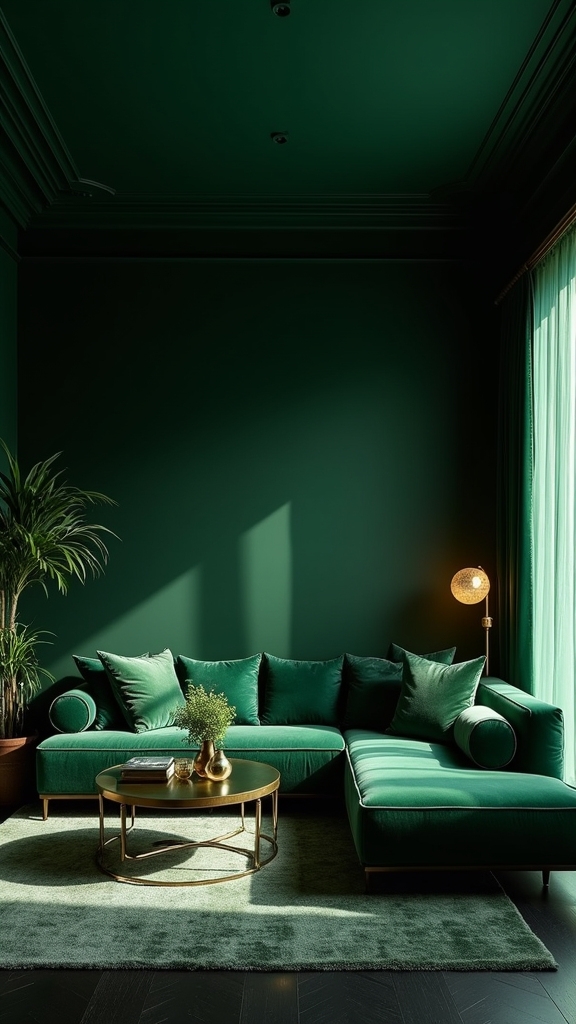
When every surface, from walls to ceiling and even trim, is cloaked in a deep, saturated green, the living room becomes an enveloping sanctuary of sophistication and depth. Opting for a dark green paint such as Farrow and Ball’s ‘Railings’ unifies the space, creating a seamless, cocoon-like effect. Dark green floors—whether hardwood or lush carpeting—anchor the room, enhancing its moody ambiance. Layering various shades and textures, such as a velvet sofa and woven rug, against this backdrop introduces visual intrigue and tactile richness. Strategic lighting, especially with warm brass fixtures, punctuates the saturated palette, highlighting architectural details with finesse. The result is a space that feels both dramatic and tranquil, encouraging relaxation and intimate conversation.
| Element | Design Approach |
|---|---|
| Wall & Ceiling | Deep, unified dark green |
| Sofa & Furnishings | Velvet, layered textures |
| Floor Treatment | Hardwood or deep carpet |
Accessorize With Greenery
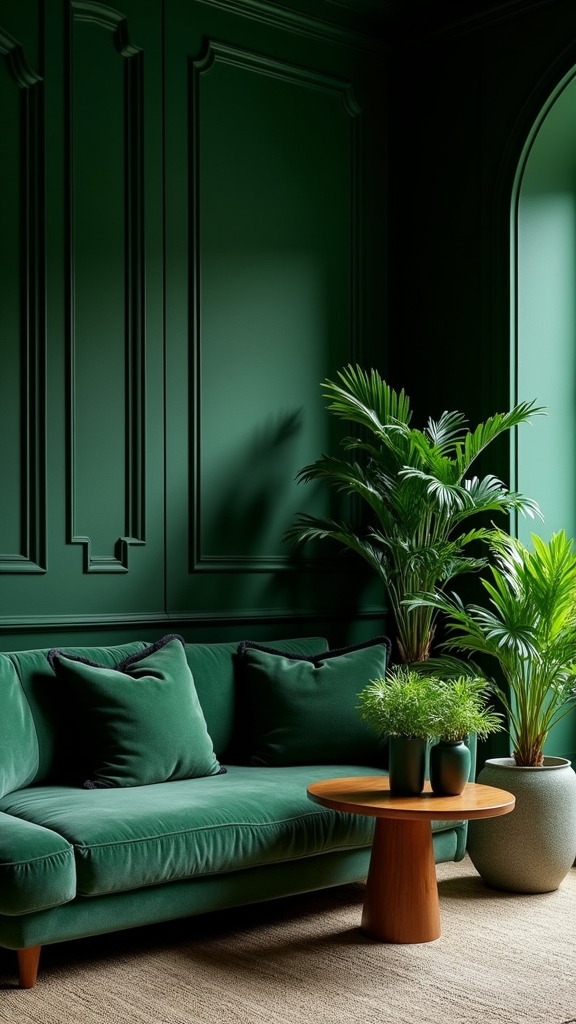
After establishing a richly layered environment with dark green enveloping surfaces, the introduction of greenery becomes a natural extension of the room’s organic sophistication.
Accessorizing with live plants—such as lush ferns or structural snake plants—infuses the living space with vibrancy and contrast, enhancing the perception of a curated green space.
Lush ferns and sculptural snake plants bring vibrancy and contrast, transforming any living area into a thoughtfully curated green retreat.
Varied heights and textural diversity achieve depth, while decorative planters in gold or blush hues punctuate the moody backdrop with elegance.
To optimize the dynamic quality of greenery, consider the following approaches:
- Layer tall floor plants with compact tabletop varieties for dimensional interest
- Select planters in metallic or pastel finishes to complement dark green walls
- Group plants by varying foliage textures for visual intrigue
- Regularly rotate plant species for a refreshed aesthetic
- Prioritize live greenery for a revitalizing, organic ambiance
Introduce English Ivy into your living room for its timeless elegance and ability to thrive in low light conditions, enhancing both air quality and chic decor.
Use Furniture to Bring in Greens
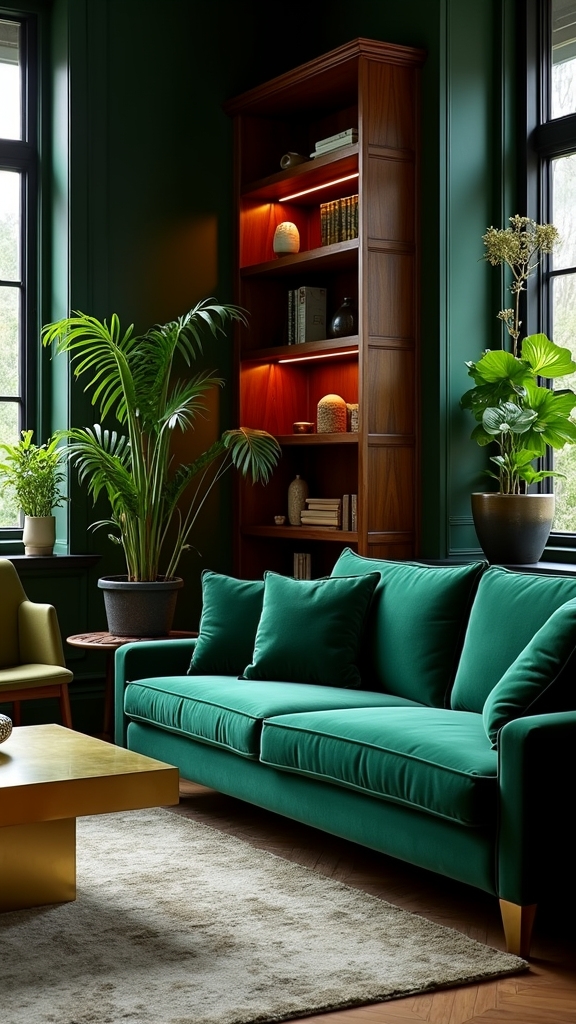
Integrating green through carefully selected furniture anchors the living room’s palette while introducing depth and tactile interest. A green sofa, such as the Drake velvet model from West Elm, serves as a luxurious focal point, infusing the space with rich color and plush comfort. For those seeking a modern look, mixing shades—like emerald, sage, or olive green—across furniture pieces creates a layered, nuanced visual narrative. Accent choices, such as a brass side table, introduce metallic contrast that enhances the sophistication of dark green upholstery. Alternatively, a neutral IKEA Stocksund sofa clad in Bemz chalk linen provides a versatile canvas for bold olive green throws or pillows. Vibrant floral cushions from House of Hackney add further dimension, amplifying the moody yet inviting atmosphere. Incorporating metallic accents like gold or brass can add a modern touch to your living room, creating a rich tactile experience that enhances the overall aesthetic.
Decorate With Antiques
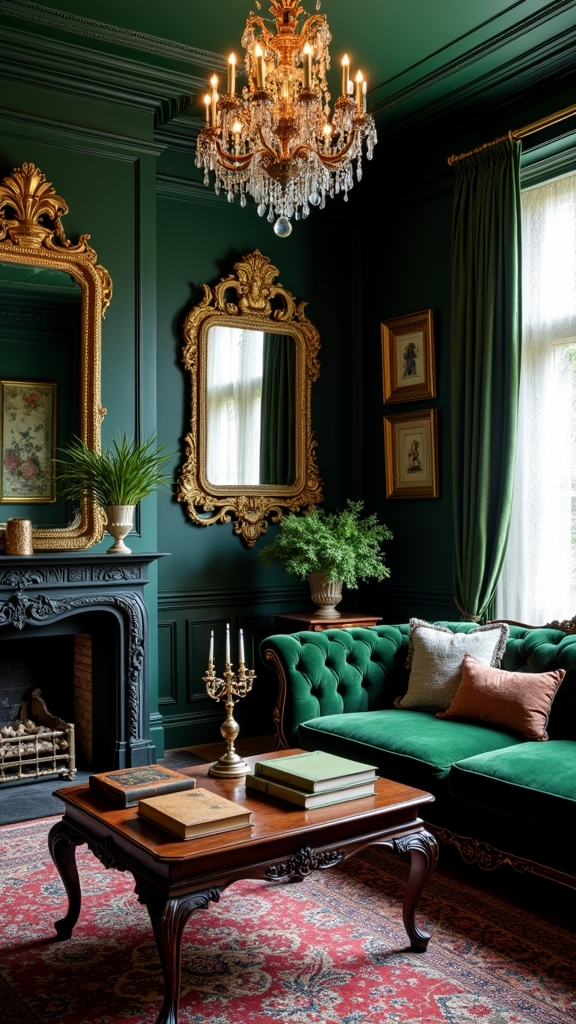
A curated selection of antiques effortlessly infuses a dark green living room with character and historical depth, establishing a sophisticated narrative within the space.
Antique furniture provides a compelling contrast against the enveloping dark green backdrop, while rich textures and patinas enhance the moody ambiance. The interplay of vintage and contemporary decor elements results in a visually dynamic environment that is both elegant and inviting.
Key antique accents, such as decorative mirrors and ornate frames, reflect light and balance the room’s depth, enhancing its overall sophistication.
Consider the following ways to incorporate antiques into a dark green living room:
- Position a vintage wooden coffee table as a statement anchor
- Incorporate worn leather trunks for functional decor
- Layer ornate brass accents for refined detail
- Curate a gallery wall with antique art
- Add a decorative mirror to reflect light
Frequently Asked Questions
What Colour Goes With Dark Green in Living Room?
When considering what color goes with dark green in a living room, designers often recommend complementary colors like earthy browns, creamy neutrals, and blush pinks, while also utilizing texture contrasts and metallic accent pieces for visual depth and balance.
How Do I Make My Room Dark and Moody?
To achieve a dark, moody room, one should layer lighting options such as dimmable sconces and statement pendants, select tactile wall textures like matte paint or wallpaper, and choose furniture with deep hues, sumptuous fabrics, and sculptural silhouettes.
How to Soften a Dark Green Room?
To soften a dark green room, one can juxtapose dark accents with abundant natural light, introduce textured fabrics such as plush throws or velvet cushions, and incorporate warm metallic elements, thereby creating a visually balanced, inviting, and tactile environment.
What Shade of Green Is Good for a Living Room?
Selecting a living room green often involves balancing undertones and light. Sage green accents introduce subtlety, while emerald green furniture acts as a statement. Forest green textiles provide depth, enhancing spatial harmony and creating a refined, layered atmosphere.
Conclusion
Dark green living rooms offer a sophisticated interplay of depth, texture, and mood. By layering tactile fabrics, integrating organic elements, and utilizing monochromatic palettes or contrasting wood paneling, designers create serene yet dramatic spaces. From floor-to-ceiling color saturation to curated antique accents, each detail enhances the ambiance. Whether through lush furnishings or verdant accessories, these approaches underscore dark green’s versatility, enabling interiors that are both enveloping and visually dynamic—ideal for those seeking an enhanced, nature-inspired retreat.
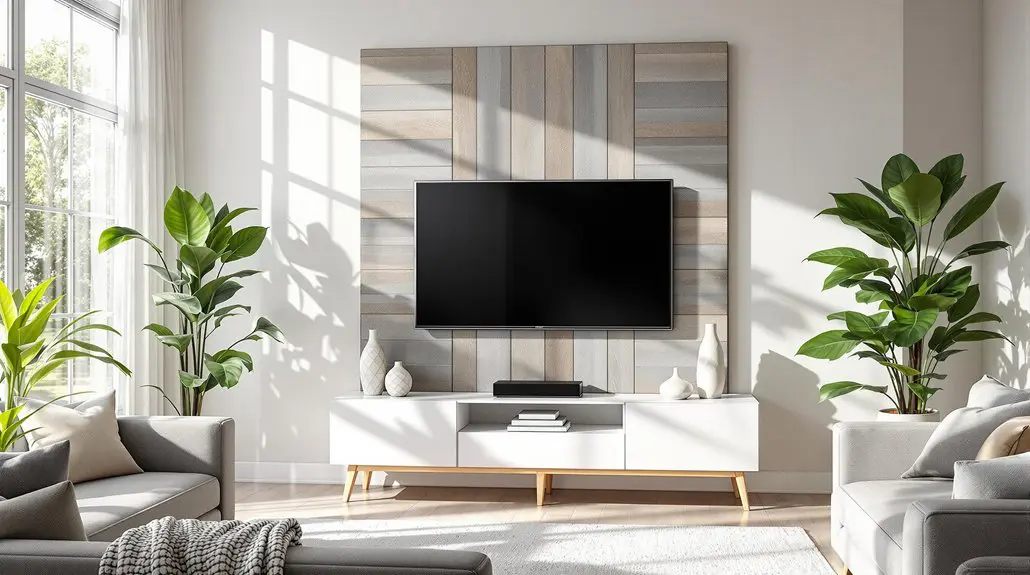
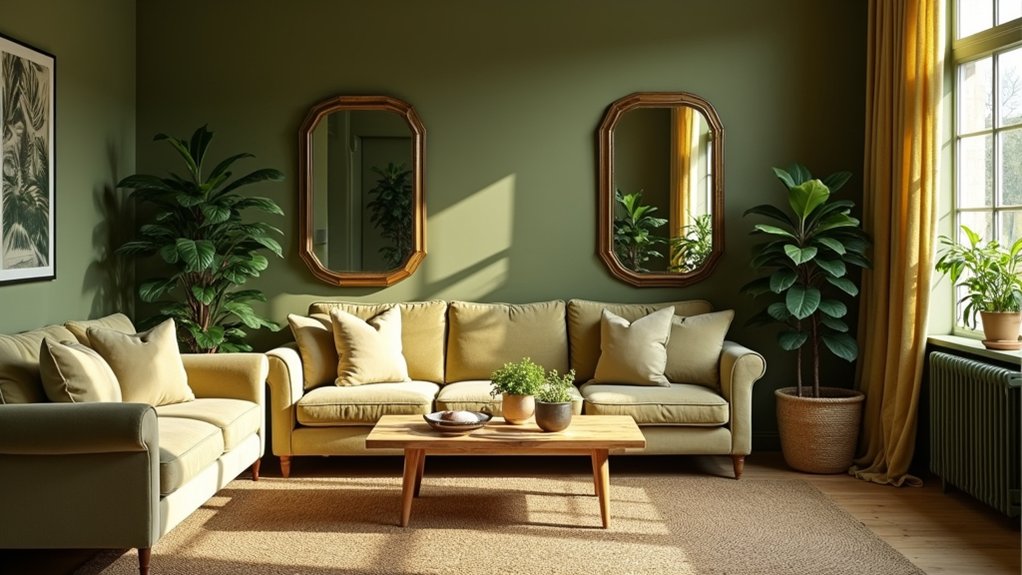
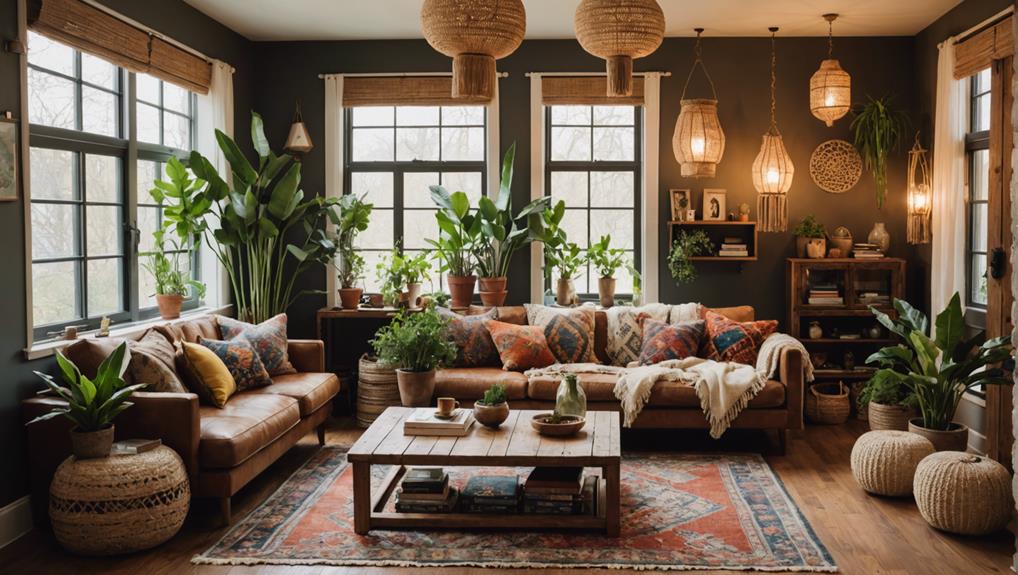
Leave a Reply